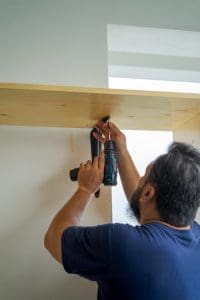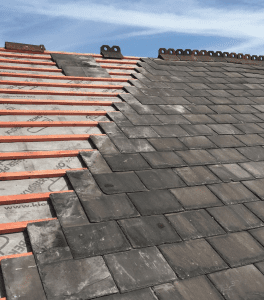As storms become an increasingly common occurrence across the UK, it’s essential for homeowners to take proactive steps to protect their roofs from the damage that heavy rain, strong winds, and hail can inflict. Your roof is your home’s first line of defense, standing between your family and the harsh elements of nature. Without proper maintenance and preparation, storm damage can lead to costly repairs and, in severe cases, compromise the structural integrity of your property. As experienced professionals in roofing, 3D Construction is here to offer insights and practical advice on how to safeguard your roof against storm damage, ensuring that it stays strong and reliable throughout the stormy seasons.
Why Storm Preparedness Is Crucial for Roofs in the UK
The UK’s unpredictable weather patterns mean that storms can strike at any time, bringing with them high winds, torrential rain, and even hail. These conditions can weaken roofing materials, tear away shingles, and create vulnerabilities that lead to leaks and other damage. The impact of storm damage on a roof can be particularly severe if existing issues, such as loose tiles or poor drainage, are left unresolved.
By taking preventative measures and addressing potential vulnerabilities ahead of time, homeowners can avoid significant storm-related damage and extend the life of their roofs. Below are some key tips to help you keep your roof storm-ready and maintain its durability in the face of extreme weather.
Regular Roof Inspections: A Preventative Approach
The best defense against storm damage is a well-maintained roof. Regular inspections are critical for identifying weak spots or areas of concern before they become major issues. Ideally, homeowners should have their roofs inspected at least twice a year: once in the spring and again in the autumn. These inspections will help spot loose or damaged tiles, deteriorating flashing, and other issues that could compromise the roof’s ability to withstand a storm.
It’s also important to schedule an additional inspection after a severe storm to check for any new damage that may have occurred. Catching problems early on can save significant repair costs down the line and help prevent further damage from future storms.
Trimming Overhanging Trees: A Simple but Essential Task
Trees surrounding your home can enhance its aesthetic appeal and provide shade, but they can also pose a significant risk during storms. Overhanging branches are particularly hazardous, as high winds can cause them to break off and crash onto your roof. This can lead to punctures in the roofing material, broken tiles, or even structural damage.
To mitigate this risk, regularly trim any branches that extend over or near your roof. By keeping trees a safe distance from your property, you not only protect your roof but also enhance overall safety, preventing damage to other parts of your home as well.
Securing Loose Items Around Your Property
In high winds, even everyday household items can become dangerous projectiles. Outdoor furniture, garden tools, and other loose items can be swept up and hurled against your roof, causing dents, punctures, or damage to the shingles. Before any major storm hits, it’s important to secure or store away these loose items to prevent them from causing damage.
For larger items that cannot be moved indoors, such as sheds or large garden structures, ensure they are properly anchored to the ground. Taking the time to secure your outdoor space will help protect your roof and property during a storm.
Ensuring Effective Drainage: Gutters and Downpipes
One of the most overlooked yet essential elements of storm preparedness is maintaining proper roof drainage. Blocked or damaged gutters and downpipes can cause water to pool on your roof, which increases the risk of leaks and water damage. This is particularly concerning during prolonged periods of heavy rain, common in UK storms.
To prevent this, regularly clean your gutters and downpipes to ensure they are free of debris like leaves, moss, and twigs. It’s also a good idea to install gutter guards to keep debris from accumulating in the first place. Ensuring effective drainage will not only help protect your roof but also prevent damage to your home’s foundations by directing water safely away from the property.
Reinforcing Roof Flashing: Protecting Vulnerable Areas
Roof flashing is a thin material used to seal and protect areas of the roof that are prone to water infiltration, such as around chimneys, vents, and skylights. Over time, flashing can deteriorate due to exposure to the elements, leaving gaps where water can seep in during a storm.
Before storm season hits, inspect your roof’s flashing and make sure it is securely in place and in good condition. If you notice any cracks, rust, or lifting edges, replace or reinforce the flashing to ensure a watertight seal. This simple step can prevent leaks and the water damage they cause to both the roof and the interior of your home.
Strengthening Roof Tiles: A Necessary Upgrade
Roofs in the UK are often constructed with tile or slate, materials that can be vulnerable to high winds. While these materials offer durability under normal conditions, storm-force winds can lift and dislodge tiles, leaving the roof exposed to water penetration. In areas prone to frequent storms, consider upgrading to impact-resistant roofing materials or reinforcing existing tiles with extra adhesive or fasteners.
Replacing any cracked or missing tiles before a storm can prevent small vulnerabilities from turning into major leaks. This proactive step not only protects your home from storm damage but also extends the lifespan of your roof by keeping it in optimal condition.
Emergency Roof Repair Kit: Be Prepared for the Worst
While preventative measures go a long way, storms can still cause unforeseen damage. Preparing an emergency roof repair kit can be a lifesaver when you need to make temporary repairs before professional help arrives. Your kit should include basic tools like a hammer, nails, a tarp, and extra shingles. If your roof sustains minor damage during a storm, these supplies will help you quickly patch the affected area and prevent further damage until more permanent repairs can be made.
Hiring Professional Roofing Services: Trust the Experts
When it comes to safeguarding your roof, there’s no substitute for professional expertise. Regular maintenance and inspections by a qualified roofing contractor, such as 3D Construction, can help identify potential issues that may be overlooked by the untrained eye. Professionals can provide tailored solutions based on the specific needs of your roof and the environmental conditions in your area.
In the event of storm damage, it’s crucial to call in the experts for any necessary repairs. Attempting to fix major roofing issues yourself can be dangerous and may result in improper repairs that compromise the integrity of your roof.
Conclusion: Taking Proactive Steps for Peace of Mind
Protecting your roof from storm damage is essential for preserving the longevity and structural integrity of your home. With the unpredictable and often extreme weather conditions in the UK, it’s important to be proactive about roof maintenance and storm preparedness. Regular inspections, trimming overhanging trees, securing loose items, maintaining gutters, and reinforcing flashing and tiles are all key steps to ensure your roof is ready to withstand even the fiercest storms.
By following these tips and seeking the assistance of professionals when needed, you can fortify your roof against the elements and enjoy peace of mind, knowing that your home is well-protected from storm damage. 3D Construction is here to help with all your roofing needs, ensuring that your roof remains a strong and reliable defense for your home, no matter what Mother Nature throws your way.




